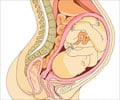The supine going-to-sleep position is associated with 2.3 times increased risk of stillbirth after 28 weeks of gestation period.

‘Stillbirth refers to miscarriage whereby the baby dies before completing the 24 weeks of pregnancy. Mothers who went to sleep on their back had at least twice the risk of stillbirth compared with mothers who went to sleep on their left-hand side.’





When a woman lies on her back, the combined weight of the baby and the womb puts pressure on the blood vessels that further restricts the normal flow of blood and oxygen to the baby. "What I don't want is for women to wake up flat on their back and think 'oh my goodness I've done something awful to my baby'," Alexander Heazell, Professor at the University of Manchester, was quoted in an interview to the BBC.
"You can't do anything about the position that you wake up in but you can do something about the position you go to sleep." The researchers studied over 1,000 pregnant women for the study and interviewed them over their sleep behaviours.
The results found that mothers who went to sleep on their back had at least twice the risk of stillbirth compared with mothers who went to sleep on their left-hand side.
Other sleep behaviours associated with late stillbirth included short and long sleep duration on the last night, getting up to the toilet only once or not at all on the last night, and daytime napping every day.
Advertisement











